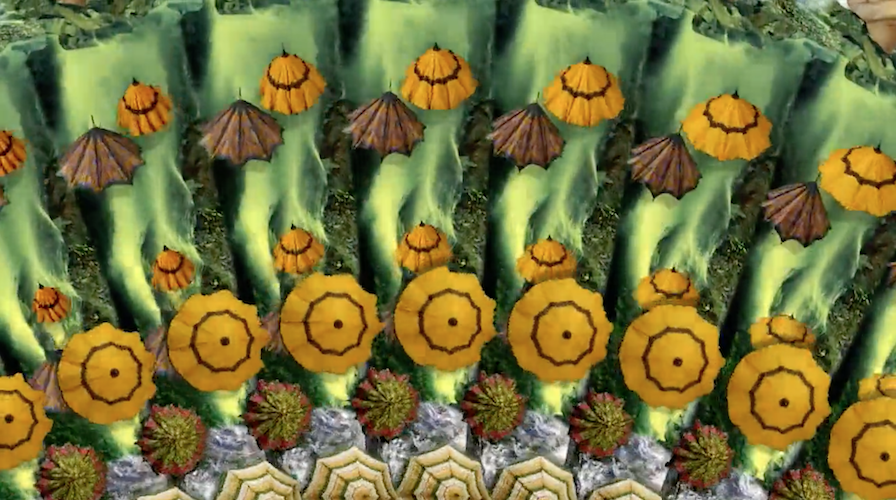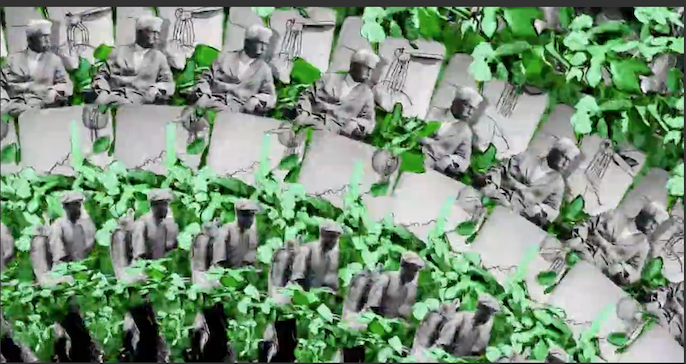In this post, I describe some of my interactive animated artworks that incorporate archival sources. In particular, I focus on three titles: Flora (2018)–which is on view at the Museum of Photographic Arts (San Diego, CA) in the exhibition Illusion: the Magic of Motion, up through January 2021–Shabamanetica (2017), and A man, a plan, a canal, Panama! (2018). As these are all motion sculptures, the majority of the material I sought-out was either sequential images or film/video. Archives used include those of the University of Pennsylvania, the Baltimore Museum of Industry, and the U.S. Library of Congress.
To make these artworks, image sequences were masked, arranged, and composited digitally then printed to vinyl adhered to a polycarbonate or aluminum substrate. The custom lamps that illuminate the works shine a steady light when the artworks are still, but strobe at a synchronous rate when the artworks are spun. At its fastest speed, the strobing is unnoticeable and exceeds the rate of film and video. This heightened temporal resolution, along with the relatively high spatial resolution of the printed image, gives an uncanny hyper-real feel to the motion pictures and CNC-routed edges that follow the forms on the outer edges. Differences in the number of images per rotation produce a parallax effect, making certain sequences appear to slide by others.
Flora (2018)
47”x47”x4”, UV-cured pigment on vinyl, polycarbonate, steel mechanism, strobe light, electronics

During walks along western Colorado irrigation ditch trails during the summer of 2018, I was transfixed by common milkweed flowers–their pudgy array of white and purple petals together formed a kind of frozen firework burst. I guiltily cut a flower and found it had half-wilted upon returning to my resident-artist studio just 15 minutes later. Flora Shallcross Muybridge, Eadweard’s wife, immediately filled my thoughts. Her lover was murdered by Eadweard, the child of their affair orphaned, and Flora died of what seemed like a broken heart. She was 24. Cut from her husband, lover, beloved San Francisco, and child, she wilted quickly. Flora’s abandonment by the busy photographer both during marriage (he often was away for months shooting landscapes) and after (he bitterly fought her attempts to secure alimony and child support) shed new light on the Muybridge story and had me look anew at the motion studies that animators have referenced for over a century. Thus began my creation of Flora, a participatory motion-portrait that comes to animated life when spun by the viewer.
Within the artwork’s complex collage of sequential images, one witnesses such scenes as a parakeet flying through wilting milkweed flowers, an aggressive nude Eadweard, a female nude endlessly watering a towering “garden” of wildflowers, shifting perspectives of western landscape forms, and a child walking around the sculpture’s perimeter (and over Muybridge’s famous panorama of San Francisco). At the very center is a photographic portrait of Flora, which was shot at the renowned Bradley & Rulofson studio and won the Philadelphia Photographer Gold Medal award in 1874. The images were sourced from my own videos shot on-location in the American West and from the University of Pennsylvania’s Eadweard Muybridge Collection archive. For the creation of Flora, I searched this archive for photographic sequences that poetically reflected pieces of Flora’s story, and some irony lies in the fact that it was Eadweard who made these images. The overall form evokes the circular glass plates that Eadweard used to project motion studies through his zoopraxiscope, a sort of magic lantern and phenakistiscope hybrid (his own invention).
Many of the Muybridge motion studies were photographed at the University of Pennsylvania, which today houses a significant archive of those original glass plates. Many plates have been digitized and are available for download from UPenn’s online Digital Image Collection. To obtain scans of Muybridge motion studies that were not available for download, I contacted the UPenn’s University Archives department, who scanned the original plates at high resolution.
Shabamanetica (2017)
96”x120”x56”, UV-cured pigment on aluminum, steel, walnut, strobe light, electronics

Shabamanetica takes the form of two large spinning sculptures that evoke ships’ wheels. The animations combine imagery from Shanghai, Panama, and Baltimore, three places connected anew by the recent expansion of the Panama Canal and dredging of the Port of Baltimore in preparation for the gigantic Neopanamax container ships. One of the two sculptures considers industrial heydays–Baltimore’s past versus China’s young and blossoming–’ghosts’ of Baltimore’s lost umbrella industry (long ago Baltimore was the umbrella-manufacturing capital of the world) fly over a landscape of Panama’s highland waterfalls where Shanghai students play with their parasols. I shot the source video for the artwork on-location. The Baltimore Museum of Industry (BMI) pulled some beautiful and unique Baltimore-made umbrellas out of their collection for me to shoot in motion (like the flying motion you see in the artwork). They also had some 2” videotape on reels in their archive that were labeled Polan Katz (a long-standing but now-defunct local umbrella manufacturer) and dated 1972, but the museum had no idea what was on them. I borrowed the reels and had them digitized–it turns out these were TV commercials for a Polan Katz folding umbrella called the Teeny Popper. The actress in the ad has this fantastic look of confusion and distress when she notices it is starting to rain–to me she was wondering “what happened to our industries?” There is another great shot of her opening and closing the Teeny Popper, which I looped to make it appear as if she is opening and closing the umbrella endlessly.
For the creation of Shabamanetica, the archive’s images (those pulled from and shot at the BMI) were collected into a digital “bin” along with the footage I shot on-location. I then emotionally focused on the idea and implications of industrial heydays while intuitively constructing the artwork’s motion-collage.
Perhaps less-considered within the realm of the archive is what I am calling the personal archive–for me, this is footage I shoot for no particular project or footage shot for a particular project but ends up not being used. For example, in 2014 I taught a workshop in Shanghai, and in my free time, I shot a video of interesting kinetic moments throughout the city. Noticing the prevalent use of umbrellas and parasols, I asked my students to bring their favorite bumbershoots to class and perform various motions for the camera. I had no idea what I would use the footage for, so the clips sat in a folder for years–they became part of my personal archive. Originally gathered for no purpose except play, those clips later became essential to the Shabamanetica project as symbols of China’s young industries.
A man, a plan, a canal, Panama! (2018)
47”x47”x4”, UV-cured pigment on polycarbonate, steel mechanism, strobe light, electronics

During the creation of Shabamanetica, I dove into Panama Canal history, which included reading The Path Between the Seas by David McCullough and visits to the canal’s Gamboa Reach and locks at both the Atlantic and Pacific Entrances. My research also uncovered a 1927 documentary entitled The Story of the Panama Canal, which turned out to be a treasure trove of film footage of construction activities shot between 1904 and 1914. The documentary, downloaded from the U.S. Library of Congress online archive, inspired the creation of and provided much of the image sequences for A man, a plan, a canal, Panama! (this title is a palindrome).Tucked within wildly undulating Panamanian jungle foliage (shot on-location), Theodore Roosevelt gestures adamantly, a steam shovel endlessly moves earth, workers from Caribbean Islands march with TNT boxes on their heads and spray oil onto waters surrounding the canal dig (in order to control mosquito populations). Dr. Gorgas, the man in charge of eliminating the malarial threat, rocks in a chair, framed by clips from the 1912 Windsor McCay film How a Mosquito Operates (downloaded from YouTube). Churning steam train wheels and a gleefully waving TR encircle a pre-canal map of the Americas. Along with the digital archive, the personal archive came into play again: while in Panama I jiggled limbs of native plants for, at the time, no other reason than to enjoy the quality of their kinetics.
Reflecting upon the use of the archive while writing this post had me realize parallels of form and content. The artworks’ phenakistiscope-like forms fall within a realm of animation George Griffin terms concrete animation, which “has one foot in the distant, pre-cinema past, and one foot on a path leading to a future of digital and manual animation” (Griffin 2007, 259). Likewise, mixing my own footage shot in the present with archival sources allowed for a motion-mashup that simultaneously looks forward and back. And while collaging the sequences, pulling from the new-school online archive made for an immediate and therefore more fluid creative process, while accessing the old-school physical archive involved human-to-human contact that opened “vaults” unavailable on the web, leading to the adventure of real-world treasure hunts. Finally, the idea of a personal archive reinforced the value of, at times, allowing intuition and play to lead one’s actions and decisions during the creative process, because the useless may someday become essential.
References
Griffin, George (2007). “Concrete Animation”, Animation: an Interdisciplinary Journal 2 (3).
Eric Dyer is an artist who brings animation into the physical world with his sequential images, sculptures, installations, and performances. Beginning with his pioneering films Copenhagen Cycles (2006) and The Bellows March (2009), Dyer continues to reinvent Victorian Era optical devices, exploring topics related to media history, our relationship with technology, kinetics as a form of artistic expression, and the relevance of physical presence in an increasingly digital world. His work has been widely exhibited at events and venues such as the Smithsonian National Gallery of Art, Ars Electronica, international animation festivals in numerous countries, the screens of Times Square, and the Cairo and Venice Biennales. Dyer teaches visual arts and animation at UMBC in Baltimore and is represented by the Ronald Feldman Gallery in New York. You can learn more about his work by visiting his website: www.ericdyer.com
